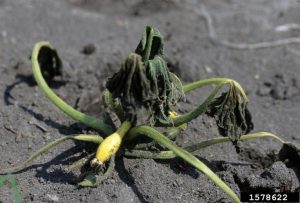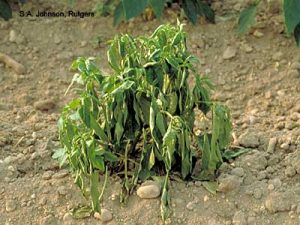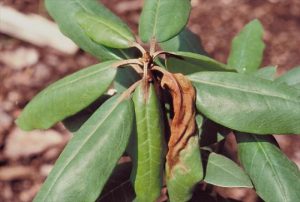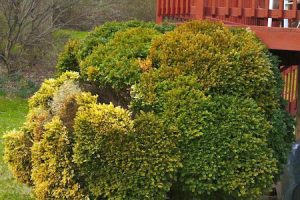Phytophthora
By William Kelleher, Fairfax Master Gardener

phytophthora on vegetable
Phytophthora (P.) is a genus (large group) of common, dangerous and difficult pathogens. In fact, P. pathogens are generally regarded as the most destructive plant pathogens known. The name, from the Greek \(\phi\mu\tau o = phyto = plant \) and \(\phi\theta o \rho\alpha = phthora = destroyer \), couldn’t be clearer or more concise. P. infestans, perhaps the most infamous species, was the cause of the Irish potato famine in the 19th century. P. ramorum causes sudden oak death which is currently devastating old forests in California and Oregon. In Fairfax County, P. most often infects woody ornamentals such as azalea, rhododendron or boxwood as dieback and/or root rot. Dieback (P. cactorum) of young leaves occurs from airborne pathogens that reside in water sitting on leaves. P. cinnamomi, the most common species, thrives in standing water pools and saturated soils and infects plants through the roots. The specific strain of P. infestans that caused the Irish famine is now believed to be extinct, but it still infects both potatoes and tomatoes in the US and around the world.

Phytophthora on pepper
Phytophthora is an oomycota (or water mold) not a fungus (or bacteria, nematode or virus). Ideal conditions are exactly what you might expect: moderate temperatures (40 to 80 degrees F) and lots of moisture: in the air, wet, poorly drained soil, rain water standing on leaves, and dense bushes that prevent the evaporation of morning dew. The key is a moderate and very moist environment. It’s easy to understand why Ireland was ground zero in 1845 to 1852.
Life Cycle and Treatment
The life cycle begins with reproductive spores (both asexual and sexual) which have thick walls to protect them while they remain dormant until conditions are right. When conditions are warm and wet, the spores produce sporangia on the plant including leaves and roots. Sporangia are receptacles in which new spores can be created asexually. The sporangia in turn produce zoospores which are expelled to swim around in the water looking for susceptible roots. When the zoospores find an entry, they create a temporary cyst that facilitates penetration. Once Phytophthora has penetrated the vascular system of the plant it begins its real vegetative growth in the form of hyphae. Hyphae can continue to grow and spread through the roots slowly making it impossible for the plant to use its vascular system to supply water up to the leaves and energy down to the roots.
Oomycetes can be suppressed with a fungicide while it is present in the soil. But once a zoospore has penetrated the roots, treatment is nearly impossible. Phytophthora spp. have multiple strategies for infecting plants both above and below ground. Some species reproduce asexually, but others are sexual, making it easier for the pathogen to develop resistance to any pesticide. Zoospores swim in ground water and can easily be blown onto an uninfected plant above ground. By whatever method the pathogen gets into the plant, via the roots or the shoots, it (i.e. the pathogen) heads for the water moving through the plant’s vascular system. Eventually the vascular system is clogged with the mold, and the plant loses the ability to hydrate. The leaves turn brown, and the plant inevitably dies.

phytophthora on rhododendron
Diagnosis on Woody Ornamentals
The diagnosis is difficult because symptoms are similar to problems with other common causes. In rhododendrons, for example, drooping leaves from disease are indistinguishable from cold weather damage from which the plant will usually recover without intervention. Yellowing of leaves is often caused by lack of water or any number of other problems, but if it’s caused by a water mold, adding water is the worst thing possible.
Over-fertilizing can damage roots and show as browning on the edges and tips of leaves. And, of course, pesticide spray can cause any of these symptoms. It is not possible to be sure that a plant has a species of Phytophthora without a laboratory test not commonly available in the field, making diagnosis and cure especially difficult.

Dying boxwood
The photo shows a boxwood more than 40 years old that has been thriving until a couple of years ago. As the supporting roots for each shoot from the ground slowly become blocked by the mold, the shoot dies completely. Pruning the diseased shoots does not slow or eliminate the progression of the pathogen.
The best way to diagnose Phytophthora is to consider the classic disease triangle. There will not be any disease unless three things are true: (1) the plant is susceptible to the disease, (2) the pathogen is present in the environment and (3) the environment is conducive to an infection. Many plants are susceptible to P. infection from one or more species including fir trees (Abies), barberry (Berberis), butterfly bush (Buddleja), Clematis, Leyland cypress (Cupressus x leylandii), figs (Ficus), Forsythia, Hibiscus, Hydrangea, holly (Ilex), lavender (Lavandula), azalea (Rhododendron), and Viburnum, among other woody ornamentals. Some have resistant varieties. Only laboratory testing will determine whether the pathogen is present in the soil, unless of course there has been a previous manifestation (which is a good reason to test a plant that is suspected of having Phytophthora). Finally, in the case of a water mold, there has to be a significant amount of water pooling around the roots, oversaturated soil and/or moisture on leaves that doesn’t evaporate.
Remedy
Fungicides can be used to prevent infections if the pathogen is present in the soil, but they will do nothing to cure a plant that has already been infected.
References
• Boxwood Blight, University of Maryland Extension
• Volutella Blight Disease of Boxwoods, University of Maryland Extension
• Root Rot on Trees and Shrubs, University of Maryland Extension
• Best Management Practices for Boxwood Blight, Virginia Cooperative Extension
• Detecting Phytophthora, Philip A. O’Brien, Nari
Williams, and Giles E StJ Hardy, Murdoch University, Wales, Australia
… updated 2023